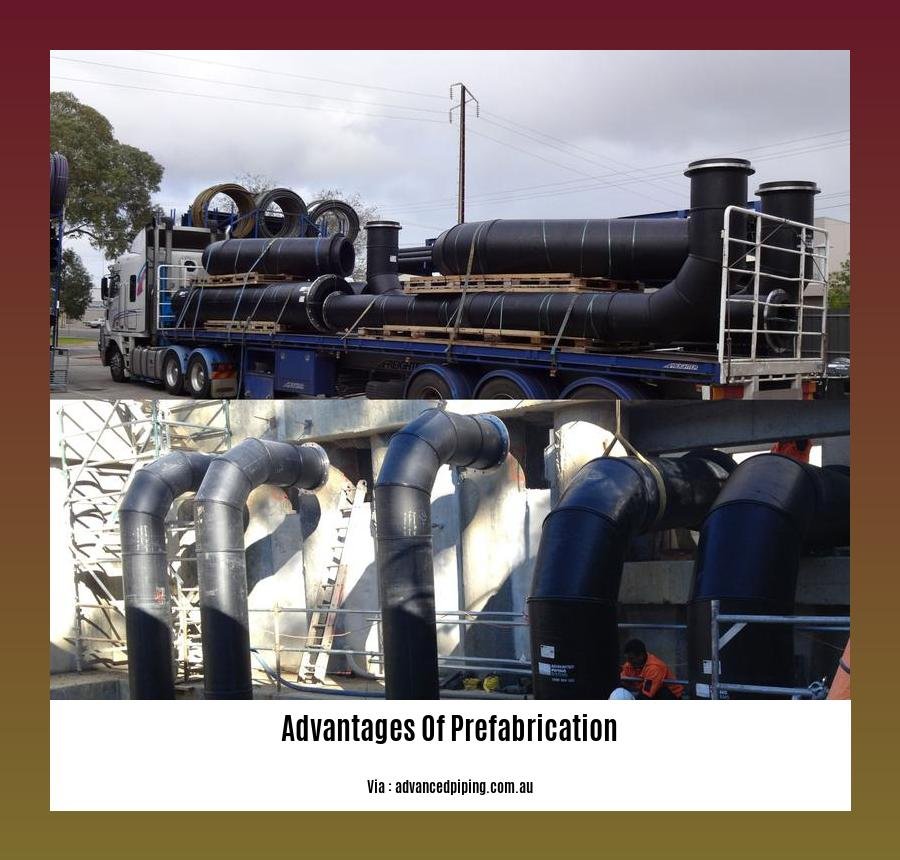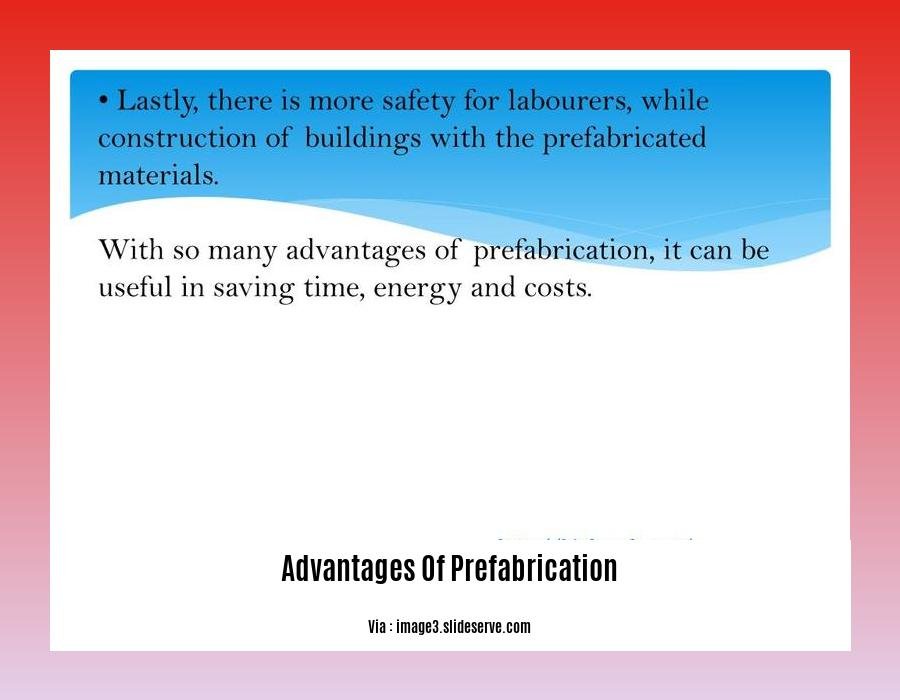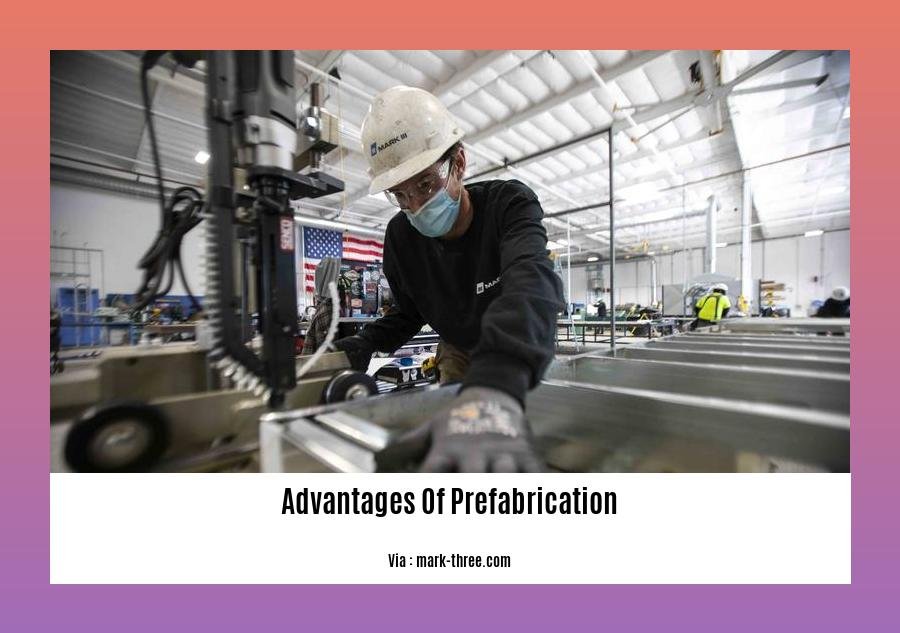In the realm of construction, prefabrication has emerged as a game-changer, unlocking a world of efficiency and innovation. [Harnessing the Advantages of Prefabrication: A Path to Construction Efficiency] explores the transformative potential of this approach, highlighting its myriad benefits ranging from cost savings to enhanced quality control.
Key Takeaways:

-
Durability: Prefabricated structures offer enhanced durability due to the rigorous quality control in factory settings.
-
Accelerated Construction Time: Prefabrication significantly reduces construction timelines by allowing for rapid assembly of components.
-
Environmental Sustainability: Prefabrication processes minimize waste and emissions, promoting environmental friendliness.
-
Enhanced Quality Control: Factory-controlled environments ensure high-quality components with consistent precision.
-
Cost-Effectiveness: Prefabrication eliminates on-site labor and material waste, resulting in overall cost savings.
-
Safety: Factory assembly reduces on-site hazards and enhances worker safety.
-
Flexibility: Prefabricated structures can be easily modified and adapted to diverse design requirements.
-
Green Construction: Prefabrication utilizes sustainable materials and processes, supporting green building practices.
-
Simplified Processes and Timelines: Prefabricated components streamline construction workflows and minimize installation disruptions.
-
Enhanced Security: Factory-controlled assembly enables the implementation of advanced security features within the components.
Advantages of Prefabrication
Increased Efficiency and Productivity:
Prefabrication streamlines construction processes by manufacturing components off-site, leading to reduced construction timelines and increased efficiency.
Enhanced Quality Control:
Factory-controlled environments allow for strict quality checks, ensuring precision and consistency in component production. This reduces the risk of defects and enhances the overall quality of the final structure.
Cost Savings:
Prefabrication eliminates costly on-site labor and minimizes material waste, resulting in significant cost savings for construction projects.
Sustainability and Environmental Benefits:
Controlled factory processes reduce material waste and emissions, promoting environmental sustainability. Prefabrication also utilizes sustainable materials, promoting green construction practices.
Improved Safety:
Factory-controlled assembly minimizes on-site risks and accidents, ensuring a safer working environment for construction personnel.
Flexibility and Customization:
Prefabricated structures offer design flexibility, allowing for easy customization and adaptation to specific project requirements.
Additional Benefits:
- Weather-independent construction
- Reduced material waste
- Higher comfort levels for workers
Conclusion:
Prefabrication offers numerous advantages over traditional construction methods, including increased efficiency, enhanced quality control, cost savings, sustainability, improved safety, and flexibility. By embracing prefabrication, the construction industry can unlock its potential for greater efficiency and innovation, transforming the way we build structures.
If you’re in the market for construction equipment, you’ll want to check out the many advantages of construction equipment. From increased productivity to improved safety, there are many reasons why construction equipment can help you get the job done right.
For those considering a career in construction management, there are many advantages of construction management to consider. Construction managers oversee all aspects of a construction project, from planning and design to construction and completion. With a strong understanding of the construction process, construction managers can help ensure that projects are completed on time, within budget, and to the highest quality standards.
Prefabricated construction is becoming increasingly popular due to its many advantages of prefabricated construction. Prefabricated buildings are constructed in a controlled environment, which allows for greater precision and quality control. This can result in shorter construction times, reduced costs, and improved energy efficiency.
Steel frame construction offers a number of advantages of steel frame over traditional wood frame construction. Steel frames are stronger and more durable than wood frames, making them ideal for use in areas with high winds or seismic activity. Steel frames are also fire-resistant, which can help to protect your home or business in the event of a fire.
Steel structures are used in a wide variety of applications, from bridges and skyscrapers to warehouses and factories. There are many advantages of steel structures, including their strength, durability, and fire resistance. Steel structures are also relatively easy to maintain and can be recycled at the end of their lifespan.
Quality Control

Prefabrication offers unparalleled advantages in terms of quality control, ensuring the delivery of high-quality construction projects. Let’s dive into how prefabrication revolutionizes quality control in the construction industry:
Precision and Consistency:
Prefabri components are manufactured in controlled factory environments with advanced machinery, eliminating human error and ensuring consistent quality. Rigorous inspections and testing processes further guarantee precision and adherence to design specifications, resulting in durable and long-lasting structures.
Controlled Environment:
Factory environments provide a stable and controlled atmosphere, free from weather fluctuations and on-site disturbances. This eliminates the risk of defects caused by rain, wind, or temperature changes, leading to components that are structurally sound and aesthetically pleasing.
Reduced Site Errors:
Prefabrication minimizes the potential for errors during on-site assembly. Precisely manufactured components fit together seamlessly, reducing the likelihood of human mistakes or miscommunications, resulting in a flawlessly executed final product.
Key Takeaways:
- Prefabrication ensures precision and consistency in component manufacturing due to controlled factory environments and advanced machinery.
- Factory settings eliminate weather-related risks and on-site disruptions, leading to high-quality components.
- Reduced on-site errors due to precision-engineered components minimize the risk of defects and costly rework.
Relevant URL Sources:
- Prefabrication for Quality Control in Construction
- Benefits of Prefabrication: Quality Control
Sustainability in Construction: Unlocking the Power of Prefabrication
As a seasoned construction professional, I’ve witnessed firsthand the many advantages of prefabrication, particularly its potential for sustainability. Prefabrication offers a promising path to a more sustainable construction industry.
Key Takeaways:
- Prefabrication minimizes material waste and optimizes resource usage, reducing environmental impact.
- Controlled factory environments ensure precision and reduced defects, contributing to enhanced durability and longevity of buildings.
- Prefabrication reduces on-site emissions and dust, promoting cleaner construction practices.
Environmental Benefits of Prefabrication:
- Less Material Waste: Prefabrication involves careful planning and efficient cutting of materials, resulting in minimal waste and lower environmental impact.
- Resource Optimization: Prefabricated components allow for precise calculation of material requirements, eliminating over-ordering and reducing resource depletion.
- Simplified Recycling: Off-site fabrication enables better waste management and recycling, contributing to a circular economy in construction.
Building Durability and Longevity:
- Quality Control: Factory-controlled environments ensure consistent quality and precision in component manufacturing, leading to increased durability and reduced maintenance needs.
- Lesser Defect Rates: Prefabrication minimizes defects by eliminating human error and relying on automated processes, resulting in longer-lasting buildings.
- Improved Safety: Precision-engineered components reduce the need for on-site adjustments and rework, enhancing safety for construction workers.
Environmental Considerations for Construction:
- Lower Emissions: Prefabrication reduces on-site construction time, which cuts down on vehicle emissions and air pollution.
- Less Dust and Noise: Off-site fabrication minimizes dust and noise pollution at construction sites, creating a healthier and more pleasant work environment.
Conclusion:
Prefabrication holds the key to unlocking a more sustainable construction industry. By embracing prefabrication, we can minimize waste, optimize resources, enhance bygg durability, and reduce our environmental impact. As we move towards a more responsible and sustainable future, prefabrication will undoubtedly play a pivotal role in transforming the construction landscape.
Relevant URL Sources:
- Prefabrication As A Sustainability Strategy – Gresham Smith
- Sustainability | Free Full-Text | Smart Green Prefabrication … – MDPI
Labor Optimization: Unlocking the Potential of Prefabrication
Prefabrication, the deliberate construction of building components off-site, offers a solution to address the ongoing labor challenges facing the construction industry. Here are the key advantages that prefabrication brings to labor optimization:
-
Reduced Labor Needs: Off-site manufacturing allows for greater control over the labor force, reducing the onsite labor requirements and optimizing workforce allocation.
-
Enhanced Productivity: Prefabrication enables specialized workers to work in a controlled factory environment, improving efficiency and overall productivity.
-
Mitigating Labor Shortages: Prefabrication can shift labor from the field to the factory, alleviating the impact of labor shortages on project timelines.
-
Improved Labor Safety: Factory-controlled environments provide a safer working environment for laborers, reducing the risks associated with traditional construction methods.
-
Reduced Labor Costs: Prefabrication optimizes material usage, reduces waste, and streamlines construction processes, leading to significant labor cost savings.
By embracing prefabrication, construction companies can effectively address labor constraints, enhance productivity, and drive overall project efficiency.
Key Takeaways:
- Prefabrication offers a solution to labor shortages and skill gaps in the construction industry.
- Off-site manufacturing allows for greater control over the labor force, reducing onsite labor requirements.
- Specialized workers in a controlled factory environment improve efficiency and overall productivity.
- Prefabrication shifts labor from the field to the factory, mitigating the impact of labor shortages.
- Factory-controlled environments provide a safer working environment for laborers, reducing risks associated with traditional construction methods.
- Prefabrication optimizes material usage, reduces waste, and streamlines construction processes, leading to labor cost savings.
Relevant URL Sources:
- Forbes: Prefabrication: A Solution to Construction’s Labor Shortage
- McKinsey & Company: Prefabrication: A key enabler for sustainable construction
FAQ
Q1: How does prefabrication enhance quality control?
Q2: What are the sustainability benefits of prefabrication?
Q3: How can prefabrication reduce construction costs?
Q4: Does prefabrication improve safety on construction sites?
Q5: How does prefabrication streamline construction processes?
- Greenhouse Storage Shed Combos: Your Guide to Combining Growing and Storage - April 21, 2025
- Greenhouse Shed Combo: Design, Build & Grow Year-Round - April 21, 2025
- Gingham vs. Plaid: What’s the Difference? A Complete Guide - April 21, 2025










